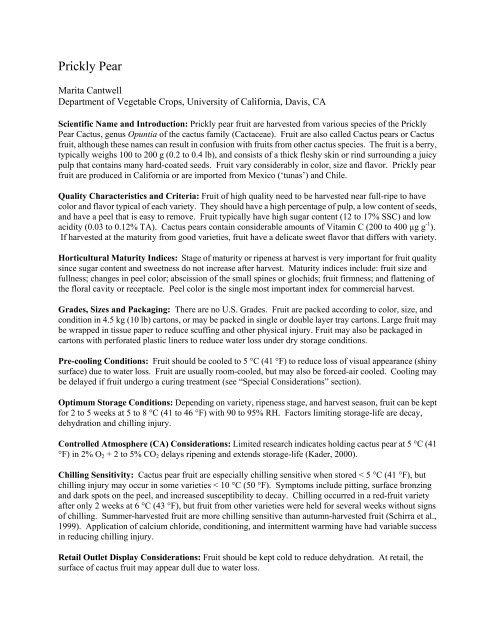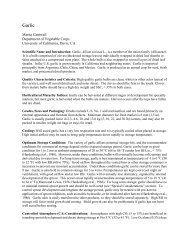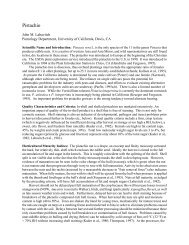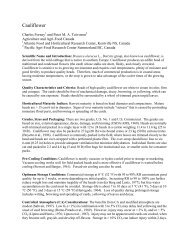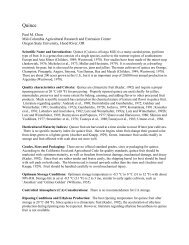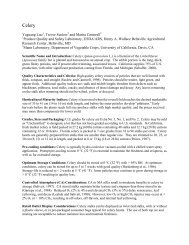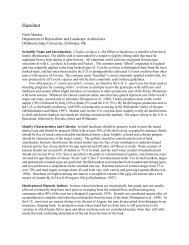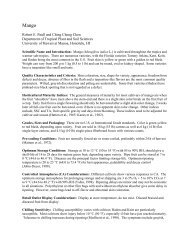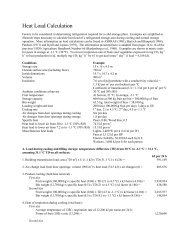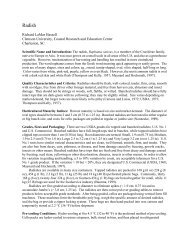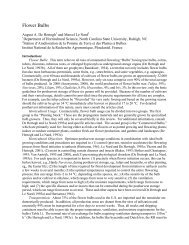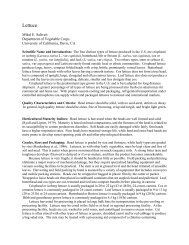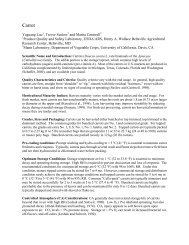Prickly Pear
Prickly Pear
Prickly Pear
You also want an ePaper? Increase the reach of your titles
YUMPU automatically turns print PDFs into web optimized ePapers that Google loves.
<strong>Prickly</strong> <strong>Pear</strong>Marita CantwellDepartment of Vegetable Crops, University of California, Davis, CAScientific Name and Introduction: <strong>Prickly</strong> pear fruit are harvested from various species of the <strong>Prickly</strong><strong>Pear</strong> Cactus, genus Opuntia of the cactus family (Cactaceae). Fruit are also called Cactus pears or Cactusfruit, although these names can result in confusion with fruits from other cactus species. The fruit is a berry,typically weighs 100 to 200 g (0.2 to 0.4 lb), and consists of a thick fleshy skin or rind surrounding a juicypulp that contains many hard-coated seeds. Fruit vary considerably in color, size and flavor. <strong>Prickly</strong> pearfruit are produced in California or are imported from Mexico (‘tunas’) and Chile.Quality Characteristics and Criteria: Fruit of high quality need to be harvested near full-ripe to havecolor and flavor typical of each variety. They should have a high percentage of pulp, a low content of seeds,and have a peel that is easy to remove. Fruit typically have high sugar content (12 to 17% SSC) and lowacidity (0.03 to 0.12% TA). Cactus pears contain considerable amounts of Vitamin C (200 to 400 µg g -1 ).If harvested at the maturity from good varieties, fruit have a delicate sweet flavor that differs with variety.Horticultural Maturity Indices: Stage of maturity or ripeness at harvest is very important for fruit qualitysince sugar content and sweetness do not increase after harvest. Maturity indices include: fruit size andfullness; changes in peel color; abscission of the small spines or glochids; fruit firmness; and flattening ofthe floral cavity or receptacle. Peel color is the single most important index for commercial harvest.Grades, Sizes and Packaging: There are no U.S. Grades. Fruit are packed according to color, size, andcondition in 4.5 kg (10 lb) cartons, or may be packed in single or double layer tray cartons. Large fruit maybe wrapped in tissue paper to reduce scuffing and other physical injury. Fruit may also be packaged incartons with perforated plastic liners to reduce water loss under dry storage conditions.Pre-cooling Conditions: Fruit should be cooled to 5 °C (41 °F) to reduce loss of visual appearance (shinysurface) due to water loss. Fruit are usually room-cooled, but may also be forced-air cooled. Cooling maybe delayed if fruit undergo a curing treatment (see “Special Considerations” section).Optimum Storage Conditions: Depending on variety, ripeness stage, and harvest season, fruit can be keptfor 2 to 5 weeks at 5 to 8 °C (41 to 46 °F) with 90 to 95% RH. Factors limiting storage-life are decay,dehydration and chilling injury.Controlled Atmosphere (CA) Considerations: Limited research indicates holding cactus pear at 5 °C (41°F) in 2% O 2 + 2 to 5% CO 2 delays ripening and extends storage-life (Kader, 2000).Chilling Sensitivity: Cactus pear fruit are especially chilling sensitive when stored < 5 °C (41 °F), butchilling injury may occur in some varieties < 10 °C (50 °F). Symptoms include pitting, surface bronzingand dark spots on the peel, and increased susceptibility to decay. Chilling occurred in a red-fruit varietyafter only 2 weeks at 6 °C (43 °F), but fruit from other varieties were held for several weeks without signsof chilling. Summer-harvested fruit are more chilling sensitive than autumn-harvested fruit (Schirra et al.,1999). Application of calcium chloride, conditioning, and intermittent warming have had variable successin reducing chilling injury.Retail Outlet Display Considerations: Fruit should be kept cold to reduce dehydration. At retail, thesurface of cactus fruit may appear dull due to water loss.
Ethylene Production and Sensitivity: <strong>Prickly</strong> pear fruit produce very low amounts of ethylene at about0.2 µL kg -1 h -1 at 20 °C (68 °F), and are not sensitive to ethylene exposure.Respiration Rates: Fruit are non-climacteric and respiration rates are low during storage. The respirationrate at 20 ºC (68 ºF) is 27 to 36 mg (15 to 20 µl) CO 2 kg -1 h -1 . Heat production is about 7,000 BTU ton -1day -1 or 1,900 kcal tonne -1 day -1 .Physiological Disorders: See section on “Chilling Sensitivity.”Postharvest Pathology: Harvest damage to the peel and stem-end of cactus fruit will lead to attack bynumerous pathogens and result in fruit decay. Common postharvest pathogens on cactus fruit are mostlyfungi and include Fusarium spp., Alternaria spp, Penicillium spp, but yeasts and bacteria also cause decay.Hot water dips at 53 to 55 °C (127 to 131 °F) for 5 min and fungicide-containing waxes may reduce surfacedecay, but are not effective when there is damage to the stem-ends. For control of decay on stem-ends, see“Special considerations.” Pre-harvest calcium sprays result in less postharvest decay (Schirra et al., 1999).Quarantine Issues: None.Suitability as Fresh-cut Product: Even after brushing and washing, the peel of intact cactus fruit mayhave irritating small spines, and a peeled packaged fruit product could be a useful option. A mixture ofCactus fruit of different colors and types could be a potentially attractive product.Special Considerations: Fruit can be bruised easily by finger compression during harvest, but damage tothe stem-end is by far the most serious mechanical injury. Damage at the stem-end can be eliminated bycareful harvest (twisting fruit from the stem or cutting fruit with a small piece of stem attached). Fruitharvested with a bit of stem may be packed that way or cured under moderate temperature of 15 to 20 °C (59to 68 °F) with airflow so the bit of stem dries and falls off before fruit are packed. This prevents damage tothe stem end and greatly reduces decay incidence. High-gloss fruit waxes are often used to improve visualappearance and reduce dehydration. This is especially important if fruit are dry-brushed to remove smalltufts of spines or glochids.References:Cantwell, M. 1995. Postharvest management of fruits and vegetable stems. In: Agroecology, Cultivationand Uses of Cactus <strong>Pear</strong>. G. Barbera, P. Inglese and E. Pimienta-Barrios (eds) FAO Plant Productionand Protection Paper No. 132, Rome Italy, pp. 120-136.Kader, A. 2000. Cactus (<strong>Prickly</strong>) <strong>Pear</strong>. Produce Facts. Recommendations for Maintaining PostharvestQuality at http://postharvest.ucdavis.edu/producefacts/index.shtml.Lakshminarayana, S., L. Alvarado y Sosa and F. Barrientos-Pérez. 1979. The development and postharvestphysiology of the fruit of prickly pear (Opuntia amyclaea Tenore). In: Tropical Foods. Vol 1.Chemistry and Nutrition, G.E. Inglett and G. Charalambous (eds), Acad. Press, NY, pp. 69-93.Piga, A., S. D’Aquino, M. Agabbio and M. Schirra. 1996. Storage life and quality attributes of cactus pearscv. “Gialla” as affected by packaging. Agr. Med. 126:423-427.Schirra, M., M. Agabbio, S. D’Aquino and T.G. McCollum. 1997. Postharvest heat conditioning effects onearly ripening ‘Gialla’ cactus pear fruit. HortScience 32:702-704.Schirra, M., P. Inglese and T. La Mantia. 1999. Quality of cactus pear [Opuntia ficus-indica (L.) Mill.] fruitin relation to ripening time, CaCl 2 pre-harvest sprays and storage conditions. Sci. Hort. 81:425-436.


